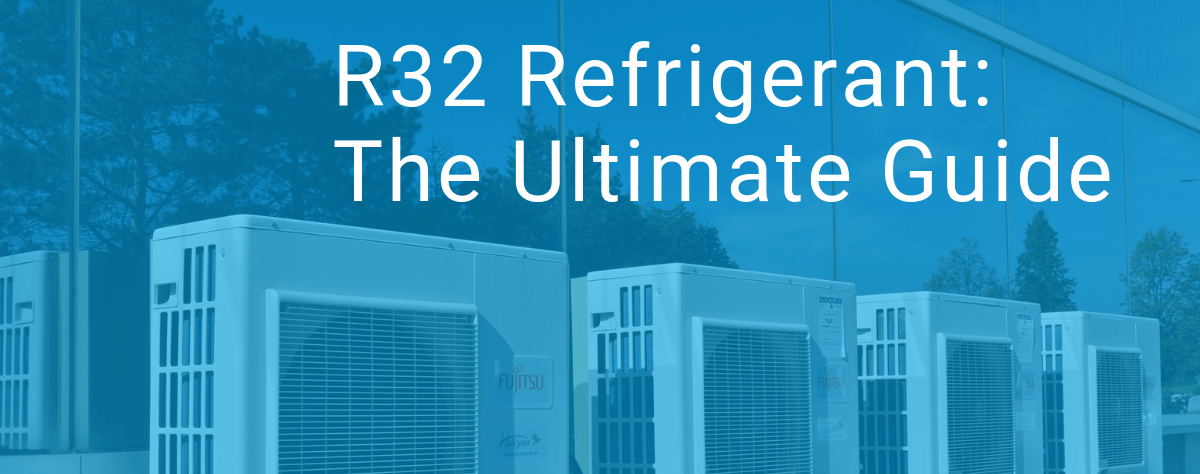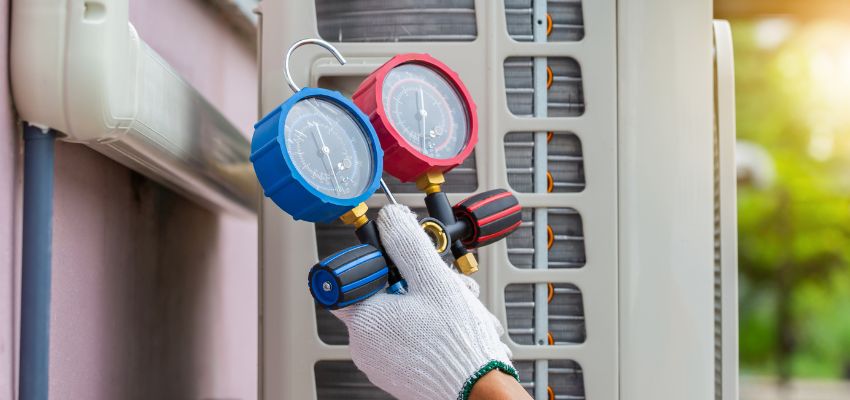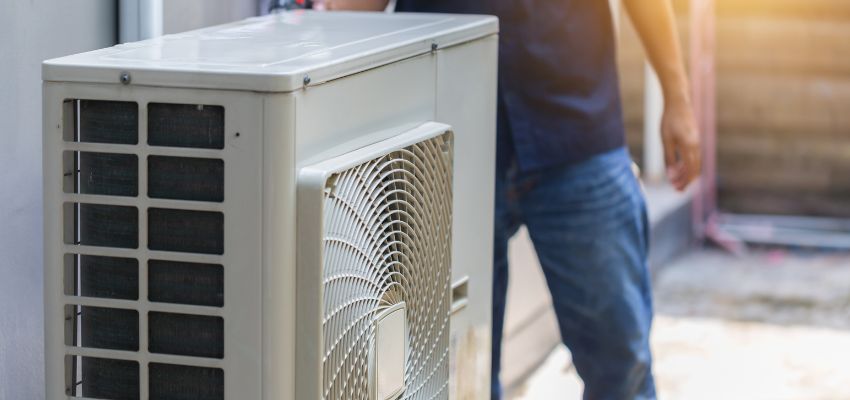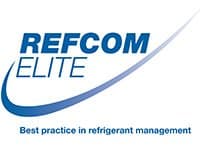
As climate change starts to see the mercury rise on a more regular basis here in the UK, more and more commercial building management companies are opting to install permanent air conditioning systems. While these types of installations do indeed provide a cool and comfortable environment for commercial properties, not all refrigerants are as cost-effective and energy efficient as we would like them to be.
Traditionally, commercial air conditioning systems have been characterised by their noisy components, large and unsightly external and internal units and expensive running costs. While they did, and many still do, run on ozone depleting HFC refrigerants, modern day air conditioning systems are designed to be much more energy efficient, easy to use and affordable.
One of the biggest driving forces behind the changes in the way commercial air conditioning operates, is the introduction of energy efficient refrigerants like R-32 that is just one small component of a new generation of refrigerant technology.
What is R-32?
R-32 is a new generation of refrigerant that will efficiently circulate between indoor and outdoor units, while actively reducing electricity consumption up to as much as 10% compared to air conditioners using existing R-22 refrigerant. It is also far more energy efficient that other refrigerants on the market and has a global warming potential (GWP) that is two-thirds lower than comparable products.
As an illustration the GWP of R32 is 675 compared to R410A (GWP 2088); R407C (GWP 1774); R134A (GWP 1430)

What are the main advantages of using R-32?
Available as a single component refrigerant, R-32 is far easier to reuse and recycle than other types of refrigerant available today. It is also affordable and cheap to produce, meaning that there will is a ready supply available for your commercial air conditioning system. Other benefits of switching to R-32 include:
- A lower GWP of around 675 – making it as much as two-thirds lower than comparable products.
- R-32 has zero ozone depleting potential (ODP) meaning it is causes zero depletion in the stratosphere. ODP is used as a measure of destructive effect of the refrigerant, and those with zero ODP are obviously far more environmentally friendly than those that have a value of 1 or more.
- R-32 is an ideal alternative for the next generation of air conditioning equipment. Following the introduction in Europe of the F-Gas Regulations and at the start of January 2015, HFC refrigerants have been phased down completely. R-32 is an excellent replacement and works well with the most state of the art, energy efficient commercial air conditioning systems available on the market today.
- It offers a far higher level of efficiency and longer pipe runs during which the refrigerant flows to and from the internal and external components. These two benefits combined make for a much more cost-effective solution.
- R-32 requires less refrigerant volume per Kw. Again, this is a perfect example of the excellent value for money this new refrigerant represents.
- R-32 is also low-toxic, is difficult to ignite and does not explode – making it safer and more effective than ever before.
R-32 – The saviour of the F-Gas regulations?
The EU aims to reduce for non-CO2 greenhouse gas emissions reduction by 60% by the year 2030. With this in mind, the all-important F-Gas Regulations came into force in 2015 and were designed to strengthen the previous measures adopted in the original F-gas Regulations of 2006.
The most important changes contained in the 2015 update include:
The limit of the total amount of F-gases that can be sold in the EU
from 2015 onwards, phasing them down in steps to one-fifth of the 2014 sales in the year 2030. This reduction of F-gas availability will be the biggest driver in the design and application of new, more climate-friendly technologies.
F-gases are a family of man-made gases used in a range of industrial applications; they include:
- Hydrofluorocarbons (HFCs) – these are used across a wide variety of sectors and applications including refrigerants in refrigeration, air-conditioning and heat pump equipment, as well as blowing agents for foams and in fire extinguishers and aerosols
- Perfluorocarbons (PFCs) are typically used in the electronics sector as well as in the cosmetic and pharmaceutical industry. In the past PFCs were also used in fire extinguishers and can still be found in older fire protection systems.
-
Sulphur hexafluoride (SF6) is used mainly as an insulating gas, in high voltage switchgear and in the production of magnesium and aluminum.

Banning the use of F-gases in many new types of equipment
Where there are less harmful alternatives widely available, the regulations state that F-gases should be phased down. This includes the use of F-gases in many every day settings including refrigerators at home or in supermarkets, both domestic and commercial air conditioning and foams and aerosols.
Preventing the emission of F-gases from existing equipment
Byensuring that property checks, and services are implemented throughout the lifespan of the appliance, and that there is always an effective recovery of the gases when the appliance is no longer serviceable, emissions can be significantly lowered.
The F-Gas Regulations are believed to be entirely achievable given the increasing availability of climate-friendly alternatives. These regulations are also the inspiration behind a wide range of innovations within the refrigeration and air conditioning sector, as manufacturers work hard to produce state of the art, energy-efficient, environmentally friendly air conditioning systems.
What are the environmental benefits of using R32 systems?
F-gases – Fluorinated gases – are man-made gases that have historically always been used across a range of industrial applications including residential and commercial air conditioning systems and units. While they do not damage the atmospheric ozone layer directly, they are still powerful greenhouse gases, with a global warming effect that is up to 23000 times greater than carbon dioxide (CO2), and their emissions are rising exponentially.
With the need to reduce noxious and potentially damaging emissions being a priority, R-32 was developed in response to new F-Gas regulations. The HCFC refrigerants that had previously been used were proven to have high global warming potential (GWP) and ozone depletion potential (ODP) and have therefore since been banned for use in new equipment, starting in 2004.
New HFC refrigerants, including R410A are better and have zero ODP but their GWP remains high at around 2,088. That means they don’t damage the ozone directly, but still have a major impact on the environment. R-32 also has zero ODP but its GWP is around two thirds lower at only 675, meaning it has a much lower carbon footprint and is therefore a viable alternative to a range of more damaging HCFC’s.
While it is easy to think of both the 2025 and 2030 deadlines as still being a long way off, manufacturers have been quick to embrace the performance characteristics of R-32 sooner rather than later, with many already introducing a full range of R-32 based operating systems to their product range. The high energy performance of R-32 has also led to the introduction of smaller, more compact units that offer better levels of performance than their existing counterparts, without any major impact on costs.
R-32 systems vs R22 systems
R-22 has been used as a propellant and refrigerant here in the UK for many years. Used as a medium for conveying heat, it is also used as a refrigerant to circulate between indoor and outdoor units. R-22 is an effective propellant, but it’s ozone-depleting components are no longer acceptable when there are more environmentally-friendly alternatives available.
R-32 is one such alternative that is currently being favored across a wide range of disciplines. It is able to effectively convey heat while being able to reduce electricity consumption by as much as 10% compared to those systems that still run on R-22. The global warming potential (GWP) of R-32 is also one-third lower, meaning that it is able to offer effective heating and cooling with a very low environmental impact.
Since January 1st 2015, it has been illegal to maintain or repair any air conditioning Systems that use R-22 Refrigerant. With this in mind, major manufacturers including Mitsubishi, Daikin, Fujitsu, Panasonic and Toshiba have developed flexible solutions to ensure energy efficient cooling in every commercial setting. R-32 not only offers lower running costs for your business, the R-32 replacement systems are also over 40% more efficient than R-22 based systems, and they have zero ozone depletion potential.
In simple terms, R-32 outshines R-22 in terms of effective heating and cooling, as well as offering substantial environmental and cost related benefits:
- It has a zero ozone depleting potential (ODP)
- It offers higher efficiency
- It is compliant with the F-Gas phase down
- It is affordable and readily available
- As a single component refrigerant, R32 it is easy to reuse and to recycle.
- R32 is also low-toxic, difficult to ignite and will not explode.
- It reduces charging volume by 30% compared to R410A
- It is ideal for the next generation of equipment and will help to future proof your investment
- It requires less refrigerant volume per Kw
- It has a higher efficiency (10% compared to R410A) => Higher COP and EER
- It delivers better performance at extreme outdoor temperatures
If you have an an R-22 air conditioning system that needs servicing, it is unfortunately not possible to replace parts or refill R22 installations. You should therefore consider the installation of a new R-32 based system before your current air conditioning system is no longer serviceable.
Similar restrictions apply to existing R410A and R422D equipment after January 2020.

Environmental benefits of R32 systems
Global warming is one of the most important environmental issues of the 21st century. Finding viable alternatives to traditional ozone-depleting chemical compounds is the bastion of environmentally friendly solutions across a wide variety of disciplines and industries.
Some components of both CFC and HCFC refrigerants, including chlorine, have long been known to be damaging to the ozone layer. While CFCs and HCFCs themselves are stable enough to remain intact as they reach the Earth’s stratosphere, they later become broken down by UV radiation where they release highly reactive chlorine atoms, which then react with and destroy the O3 of the ozone layer.
Developed countries across the globe are working to reduce their carbon footprint by using refrigerants with relatively low global warming potential. The F-gas regulations of 2015 are designed to phase out the use of potentially damaging HFC refrigerants until they become almost completely obsolete by the year 2030.
Refrigerants that have a high global warning potential are being phased out of commercial air conditioning systems and refrigerants. Alternatives such as R-32 offer a low GWP of as little as 675 – an impressive 70% reduction on comparable propellants and refrigerants.
Should you change to R-32 for your commercial air conditioning?
The decision by air conditioning manufacturers to transition to a new refrigerant was driven by a variety of factors, including the overall impact on the environment, energy efficiency, safety concerns and value for money. R-32 meets the criteria for improving all of four of these major considerations.
With this in mind, switching your air conditioning refrigerant over to R-32 will not only make your business compliant with F-Gas regulations, it will also help to rapidly reduce your carbon footprint, and be much more cost effective and energy efficient as well.
Whatever your individual requirements, there will be a R-32 compatible system to suit the needs of your building. There are almost all kinds of RAC and PAC air conditioning systems that have been designed with the use of R-32 in mind, and most major manufacturers have compatible, cost effective systems that offer a range of technological advances as well as improved environmentally efficiency.
R-32 offers the perfect storm and takes into consideration the 4 key criteria of the regulations:
– Environment
– Energy
– Efficiency
– Safety and Economy
It is a single component refrigerant which means it is incredibly easy to use and recycle when needed. Its ability to utilise familiar technology also makes it relatively inexpensive to produce.
Safe to use with a low-toxicity and being incredible difficult to ignite makes it the leading choice for air conditioning systems that are designed to comply with F-gas regulations, while delivering a much lower GWP.
It is also important to remember that by the year 2025, refrigerants with a GWP greater than 750 (such as R410A, R134A and R407C) will be banned from being installed in new split air conditioning systems, and the use of R410A, R134A and R407C will be heavily restricted, so you should consider making the change as soon as you are able.
From January 2020, there will be a ban on using refrigerants with a GWP greater than 2500 in servicing or maintaining existing equipment. This applies to refrigerants such as R404A and R422D. Therefore any breakdowns after this time will not be able to be repaired if refrigerant is required.

R-32 FAQ’s
Why do I need to switch to using R32?
The new EU F-Gas Rules have been put in place to reduce emissions and move towards lower GWP solutions in a series of predetermined phases. The regulations require that the consumption of HFCs is reduced by 37% by 2020 and 79% by 2030. In order to achieve this, air conditioning systems with less than 3kg of refrigerant charge must contain a refrigerant with a GWP of less than 750. R-32 is the current favourite replacement refrigerant offering high efficiency and a low GWP.
How efficient is R32?
R32 is incredibly efficient and has the working pressure is similar to that found in R410A at around 12-26 bar (174-377 Psi). But what makes it all the more impressive is its ability to exchange heat-load and deliver at a higher capacity making it much more efficient. R32 also has a significantly higher volumetric cooling capacity than R410A that can help reduce the system pipe size which also increases efficiency and reduces costs.
How safe is R32?
R32 is classified as A2L, meaning that it is a low flammability refrigerant with a maximum burning velocity of <10cm/s. In simple terms this means that it is not explosive and the possibility of fire spreading even if it did ignite is incredibly low with a very slow flame propagation speed.
As with all refrigerants and compounds, you should leave the handling of any gases under pressure to experienced and properly instructed air conditioning professionals. You should also never attempt to repair pipes or units on your own. It is also advised to always ensure that there is enough air flow in the space where any gases or components are being installed.
Where can R32 systems be installed?
R-32 systems are an excellent choice for commercial spaces, and there are a range of flexible systems offering high performance across a complete range of operating environments. With its increased volumetric cooling capacity, R-32 based systems can run with a reduced pipe size and require around ¼ less charge compared to R410a air conditioning or heat pump systems. This ensures the R-32 systems are able to remain incredibly efficient for longer
From a financial point of view, the cheaper running and maintenance costs could see your initial investment for a new R-32 based system, redeemed in just a few short years.
Are there any incentives for switching to R32?
Apart from the obvious need to meet F-gas regulations there are other incentives in place for switching to R-32. The Enhanced Capital Allowance (ECA) is a scheme provides businesses with enhanced tax relief for investment in energy-saving equipment that meets specified Government criteria. It allows 100% of the investment to be written off against taxable profit in the year the investment is made.
The Energy Technology List (ETL) is a definitive list of all the products that qualify for the ECA, typically by meeting or exceeding efficiency standards and there are many R32 systems that have the highest energy efficiency rating of A++ included on the list.
Why haven’t we heard of R32 before?
Although R-32 is currently enjoying a significant boost in popularity here in the UK, it has actually existed for many years and is already widely used in Japan, Australia and India. Many major manufacturers the world over are switching to systems charged with R-32 as it offers an affordable, economical, energy efficient alternative to HFC’s.
R-32 equipment certainly shouldn’t be considered to be “new” or “experimental” in any way, as it has already been used successfully in Japan, where there are already over 10 million units installed and operating.
Can I use R32 in my existing air conditioning system?
R32 can not be used as a drop-in replacement on existing R22, R407C and R410A systems. As an A2L refrigerant it is not suitable for retrofitting, and charging an existing system with R32 could increase unnecessary wear on the compressor, cause permanent and irrevocable damage to working component or even present a safety risk for the user.
Is it easy to install?
All air conditioning systems should be designed and installed by an experienced air conditioning specialist. In the case of of R-32 based systems, the installation is similar to existing R410A units, meaning your air conditioning specialist will be able to make use of a wide range of tools and components that are already widely available. This will help to keep costs down and reduce installation time.
R-32 air conditioning systems in Bristol
Affordable, energy-efficient commercial air conditioning systems across Bristol and the South West are now being designed to offer high performance and a low carbon footprint. Here at Total Environmental Kooling have over 20 years’ experience in the air conditioning and ventilation industries, and we remain one of the most experienced air conditioning companies in Bristol.
Our professional design and air conditioning installation specialists are on hand to design and install energy efficient commercial R-32 air conditioning systems for commercial, industrial, public and private sector customers in Bristol and throughout the UK. We offer complete air conditioning and climate control solutions for building and offices in Bristol and beyond.
If you are considering switching to an R-32 installation, it is vital that you ask a professional and experienced commercial air conditioning specialist to undertake the work for you. Complex regulations, energy saving initiatives and the ongoing service and maintenance needs of a state of the art R-32 air conditioning system, should be left to the professionals.
Apart from R-32 system, Total Environmental Kooling has a wide range of commercial air conditioning systems that cater to buildings of any size and use. Speak to us today on 0117 952 3355 or use our contact form to find our more.






